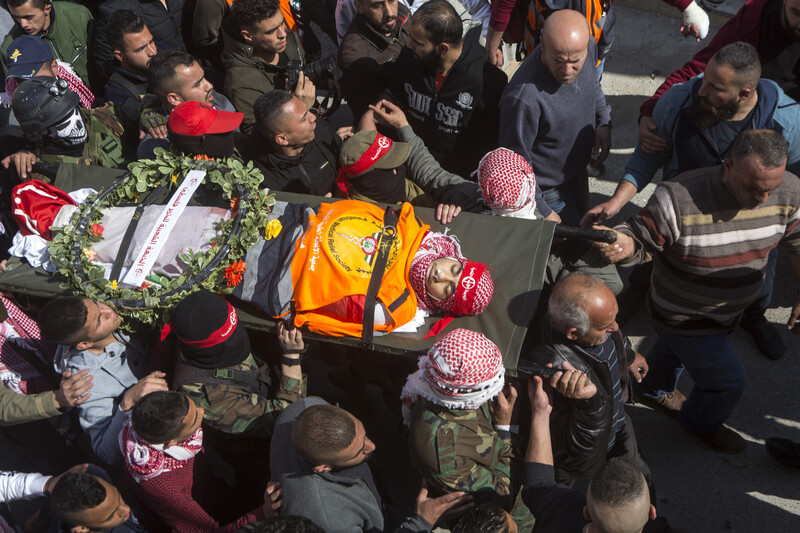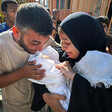Rights and Accountability 30 March 2019

Sajid Mizher, killed while on duty as a volunteer medic, was buried wearing his paramedic vest, Dheisheh refugee camp, 27 March.
ActiveStillsWhile eyes are on Gaza on the eve of the Great March of Return’s first birthday, Palestinian fatalities at the hands of Israeli occupation forces have spiked in the West Bank.
Of the 31 Palestinians killed by soldiers and settlers so far this year, 16 were slain in the West Bank, 10 during the month of March alone.
With nearly 200 Palestinians killed and more than 6,500 wounded by live fire during the Great March of Return, human rights groups have called for Israel to release its rules of engagement, which the state has refused to disclose.
Last May, Israel’s high court gave the military the green light to continue its use of sniper fire against protesters in Gaza, ruling that protesters posed a danger to soldiers and civilians.
Killed while posing no threat
That ruling contradicted the findings of human rights groups – and ignored video evidence to the contrary – showing that Israel has killed and maimed unarmed protesters, journalists and medics who posed no danger to soldiers on the other side of the Gaza boundary fence.
In multiple cases this month, the Israeli military has justified the fatal use of live fire on the grounds that Palestinians were “throwing stones” or had thrown fire bombs.The human rights group B’Tselem has noted that Israel frequently justifies its killing of Palestinians by expanding what constitutes “life-threatening” behavior “to include circumstances in which soldiers’ lives are not actually in danger, such as stone-throwing or tire-burning during protests.”
Stone-throwing was the justification given by the military for killing Ahmad Manasra, 23, after he tried to help a family with their broken-down car at the southern entrance to Bethlehem, a city in the West Bank, last week.
According to an investigation by the Israeli journalist Gideon Levy, Manasra was traveling home from a wedding along with three friends when they found a woman at a traffic light screaming for help.
The four friends came to the woman’s aid. She had been traveling with her husband and two small daughters when their car broke down. When her husband stepped out to inspect the vehicle, he was shot in the stomach by Israeli soldiers.
Three of the friends returning from the wedding transported the man in their car to the hospital. Ahmad Manasra stayed behind to help the woman and her daughters.
According to Levy’s telling, Manasra had tried to start the stalled car and move it away from the intersection. When his attempt failed, he got out of the car.
The soldiers, presumably the same ones that had shot the owner of the car, opened fire again. Manasra tried to take cover behind a concrete block but he was shot multiple times throughout his body.
The military’s explanation for Manasra’s killing, as given to Levy: “An IDF fighter who was on guard at a military position near the intersection spotted a suspect who was throwing stones at vehicles in the area and carried out the procedure for arresting a suspect, which ended in shooting.”
No explanation
The military made no attempt to explain the 4.5-minute gap between an alleged car ramming attack on soldiers in the central West Bank and the multiple gunshots that took the lives of Amir Mahmoud Darraj and Yousif Raed Anqawi on 4 March.
Video recorded on Facebook Live shows that a single shot was fired after the two Palestinians’ car collided with two soldiers whose military vehicle was stuck on the dark road in Kafr Nimeh village:
After nearly five minutes, six more shots were fired. Twenty seconds later, another two shots. And then another shot less than half a minute later.Eyewitness testimony given to B’Tselem suggests that the young Palestinians didn’t see the military vehicle on the road.
Israeli forces confiscated security camera footage from a nearby property and tried to cover the young Palestinians’ bloodstains with earth.
When asked about the time lapse between the collision and the soldiers’ shooting, the military gave no explanation, saying that “terrorists” tried to run over a soldier and Border Police officer. “In response, the force that was at the scene opened fire and neutralized two of the three terrorists.”
A third Palestinian who was traveling in the back seat of the vehicle with Darraj and Anqawi hit his head and lost consciousness in the crash. He was not shot and was arrested and released a few days later.
The military claimed that there were firebombs in the car. One soldier was seriously injured in the collision. Israel has detained the bodies of Darraj and Anqawi.
Volunteer medic killed
Earlier this week, Israeli soldiers shot and killed a volunteer medic with the Palestinian Medical Relief Society during confrontations between protesters and the military in Dheisheh refugee camp near Bethlehem.
Sajid Mizher, 17, was shot in the stomach with a live bullet.
Israel claimed that it only used riot control weaponry against Palestinians who were throwing fire bombs toward soldiers.
Mizher was wearing a reflective vest and rescue service uniform when he was shot. Mizher is the fourth Palestinian medic to be killed by Israeli soldiers in the past year. Three medics have been slain while on duty during Great March of Return protests in Gaza.“Routine unlawful killings by Israeli forces and full impunity in Israel highlight the need for the International Criminal Court to open a formal probe into serious crimes committed in Palestine,” Omar Shakir, director of Human Rights Watch’s Jerusalem office, said after Mizher’s killing.
The UN commission of inquiry investigating Israel’s deadly crackdown on the Great March of Return stated in its report that Palestinian territory under Israeli occupation is “one of the most dangerous places in the world to be a health worker.”
This story has been updated to correct Sajid Mizher’s age.






Comments
Sue Israelis in ICC
Permalink David Moore replied on
I will say it again, having said it a million times, sue the snipers in the ICC. The sniper, unless known, will be listed as "John Doe #1," but include local commanders and whoever issued the order (including court judges). That way, I hope they enjoy never leaving Israel, because an active arrest warrant will be issued. When they can't travel back to the US, or anywhere else, shooting medics won't be so fun. I would love to see an Israeli judge who declared this legal to banned from receiving any foreign awards.